|
The
Launch of the
National LGBT Veterans Memorial
at the Congressional Cemetery
Washington D.C.
by Denny Meyer |
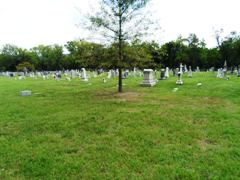 |
It all began many years ago in the
early 1980s when Air Force TSgt. Leonard Matlovich,
discharged for being gay, still walked the
Earth like an ordinary mortal. He wrote, "I
believe we must be the same activists in our deaths that
we are in our lives. I urge those of you who are
facing death to find a method of leaving a lasting
record of your accomplishments-including the
acknowledgement that you were lesbian or gay."
He was a genuine American hero, with over a decade of
sterling service, a Purple Heart, and Bronze Star for
his sacrifice and valor in Vietnam. He arranged
for his own burial at Congressional Cemetery, and
designed his tombstone which reads: "A Gay Vietnam
Veteran. When I was in the military, they gave me
a medal for killing two men, and a discharge for loving
one." There will be more on Matlovich later.
This past August, nearly a quarter
century after Matlovich's death, the National LGBT
Veterans Memorial (NLGBTVM) issued a press release
announcing the launch, by military veterans, of the
project in Washington DC to create "a visible and
lasting testament to the contribution gay, lesbian,
bisexual and transgender service members have made to
the security of the United States."
"A
National LGBT Veterans Memorial Is Being Built At
Historical Congressional Cemetery Located In
Washington, DC
The Board of Directors of NLGBTVM has entered into
an agreement with the Board of Directors of Historic
Congressional Cemetery to establish the Memorial
there and has purchased cemetery plots for the
project. The plan includes the option to inter
cremains for those veterans who wish to be
memorialized on site. For those who want to have
their service recognized but who do not want to bury
their ashes, there is an option to buy a brick
engraved with their service information.
The plan includes accepting designs for the
Memorial/Monument submitted by artists nationwide. A
committee will select from the designs submitted
those that best meet the requirements and then those
will be juried by a committee of professionals to
select the winner of the design contest.
Nancy Russell, a retired Army LTC and Chair of the
NLGBTVM Board of Directors said, “The time has come
for those of us who were forced to serve in silence
to honor our fellow veterans with a dignified and
impressive memorial in our national capitol. The
National LGBT Veterans Memorial will provide a
fitting resting place where our veterans may, as
Leonard Matlovich urged us to do, ‘leave a lasting
record of our accomplishments’.”
NLGBTVM is targeting Memorial Day 2014 for a
dedication ceremony. Those who want more information
or to donate should go to the website at
www.nlgbtvm.org"
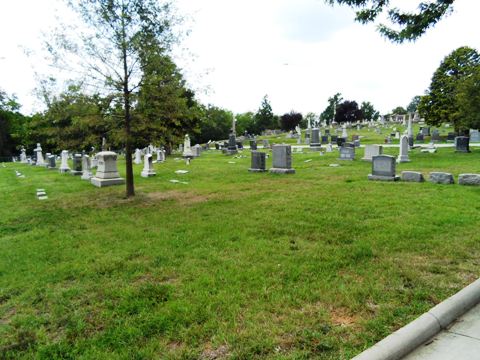
According to LTC Russell (USA
Ret.), the project was conceptualized ten long years ago
with the idea of a memorial monument, at
Congressional Cemetery in the nation's capitol, that
would represent LGBT veterans from across the entire
country and provide them with a proper and prominent
place to memorialize their service. At that time
she and Patrick Crowley, then a volunteer worker at the
Congressional Cemetery and later its chairman, got
approval for their concept and began to work
out the details. Naturally, the devil is always in
the details; and it took a decade of determination and
stamina to make it a reality. Among many problems
was the flooding of the Anacostia River onto the lower
section of Cemetery originally selected as the site for
the monument and funding delays in planned landscaping; along with a right-of-way ownership issue of a
road through that section. Finally, in September
of 2011, coincidentally coinciding with the repeal of
Don't Ask Don't Tell, all was ready for the project to
begin at long last. With fundraising proceeding,
in May of 2012 a deposit was made for the initial plots
with planned room for further expansion. Nothing
is ever easy, is it.
The project has begun with payment for six of ten planned plots, with
additional plots available as fundraising and demand for
space progresses. Depending on the outcome of a
planned monument design competition, there will
initially be room for up to sixty cremains and eighty to
one hundred memorial bricks. Each plot will hold
four to six urns.
At present, according to LTC
Russell, participation is possible in three ways:
-Those wishing to simply support the project may make a
donation by visiting the monument's official website at
www.nlgbtvm.org
-LGBT vets wishing to inter all or part of their cremains
may reserve a space, for a donation of $2,500
which may be given in installments.
-LGBT vets wishing to be memorialized may have a
brick for a donation of $500 which also may be given in a few
installments.
Obviously, donations are
essential for this project, which was envisioned by Leonard Matlovich,
who challenged us to leave a lasting legacy of our
accomplishments.
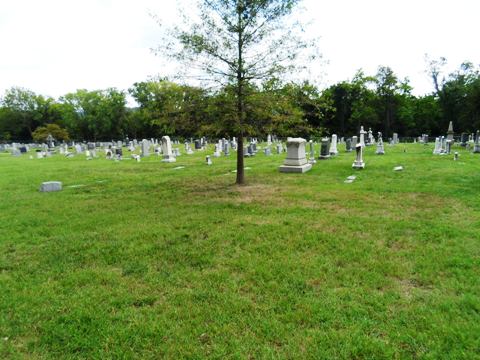
"The memorial will be a visible and lasting
testament to
the contribution that gay, lesbian, bisexual, and transgender
service members have made to the security of the United
States. The monument's design is envisioned as being
impressive yet dignified, suitable to the patriotic
service that we have given over the years. For
those asking why the memorial will not be at
Arlington National Cemetery in Washington, the answer is
that they do not put any memorials there, except for a
very few such as for The Unknown Soldier, and President Kennedy who
served in World War II. Memorials on the Capitol
Mall require Congressional approval, which is unlikely
anytime soon," said Russell.
Interestingly, those very
thoughts were on the mind of Leonard Matlovich, some
thirty years ago, as he began thinking of where and how
to park himself for eternity in a lasting memorial to
LGBT service. His longtime friend and the
chronicler of his legacy, Michael Bedwell, recounted how
Matlovich's monument came to be at Congressional
Cemetery:
"Although it was a
few years before the AIDS crisis hit, and his own
diagnosis, Leonard first began thinking of being
buried someday in Congressional Cemetery when he
discovered it on one of his frequent walks near the
duplex we shared just a few blocks away. In addition
to appreciating its overall history, more than
half-a-century older than Arlington National
Cemetery, he was intrigued by some of its residents.
They include Peter Doyle, considered by many to have
been the man that gay American poet Walt Whitman
loved most; and possible lovers, infamous FBI
director J. Edgar Hoover and his closest friend and
heir, Clyde Tolson. Then, when we visited Père
Lachaise Cemetery in Paris in 1984, he was moved by
the constant stream of visitors to the grave of gay
icon Oscar Wilde, and the shared gravesite of famous
lesbian couple Gertrude Stein and Alice B. Toklas,
and decided that gays in America also needed
memorials to those who’d come before. Knowing that
only huge public figures such as the Kennedy
brothers are allowed by Arlington to install any
tombstone there other than the generic-inscribed 42
x 13 x 4 inches version issued by the Veterans
Administration, he purchased two plots in
Congressional Cemetery, numbers 161 and 162 in row
20, one for himself and the other for a hoped-for
future lover. As a kind of last laugh on Hoover and
Tolson who were known to have used the Bureau to
harass gays, he chose the same row they are buried
in; Tolson's is plot number 156 with its ironic pink
granite marker while Hoover's is number 117 in a
family plot further down.
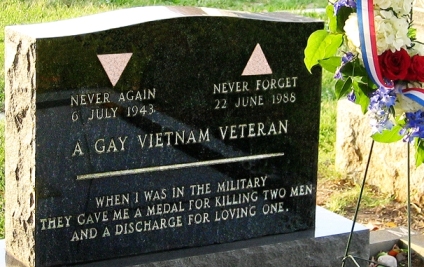
He designed a headstone that
would also serve as a memorial
to gay veterans using the same
kind of reflective black granite
that formed the capital’s
Vietnam Veterans Memorial Wall,
and adding two pink granite
triangles in memory of gay
victims of the Nazi Holocaust.
It would not bear his own name;
his last name alone was to be
engraved at the foot of the
grave on its granite coving. In
1987, he and a friend proposed a
memorial in Congressional
Cemetery for slain gay
supervisor Harvey Milk. In an op ed in "The Advocate" prior to
the dedication ceremony during
that year's gay march on
Washington, he recalled:
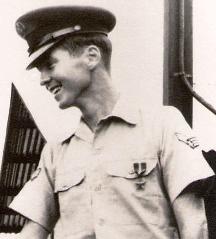 |
“Even after I returned to the
United States, I couldn't seem
to get the images [in Paris] out
of my mind. The knowledge that I
could never have had that
experience in my own country
made me increasingly frustrated
and angry. I knew, for example,
that when Americans went to the
Vietnam Memorial to remember and
honor those who gave their lives
fighting in that horrible war,
it never occurred to them that
some of those who were the
strongest, bravest, and most
heroic were also gay. ... When
confronted with our own
mortality, it has become common
in our community to have our
bodies cremated and our ashes
thrown to the four winds. But
with the wind goes an important
part of our history. And also an
important part of our future.
I ask you to consider the
|
|
ramifications
of this action on tomorrow’s generation
of lesbians and gays as they search for
self-esteem. I believe that we must be
the same activists in our deaths that we
were in our lives. I urge those of you
who are facing death to find a method of
leaving a lasting record of our
accomplishments—including the
acknowledgment that you were lesbian or
gay.”
(http://www.advocate.com/health/aids-30-years-war/2011/05/05/30-voices-past-30-years) |
Directions to
Leonard Matlovich's grave:
http://leonardmatlovich.com/images/DirectionsLeonardGrave2.pdf
As a gay Vietnam Era veteran of
ten years service in silence, the establishment of the
National LGBT Veterans Memorial means a lot to me
personally. As I recounted in a CBC radio
interview in August, I could never have imagined, when I
served, that someday we would be able to serve openly in
pride of both our service and who we are. I told
the story of how I first met and became friends with
Leonard Matlovich at the Castro Street Fair in San
Francisco in 1979. "Lenny had just recently
arrived and been welcomed as a hero by the gay
community. At the fair, he set up a booth with a
hand lettered sign reading 'Leonard Matlovich for Board
of Supervisors.' My eyes popped out and I ran over and
said to him, "You are my hero, because I served in
silence." And that tall handsome moustacheod Air
Force sergeant bent down and kissed me. I didn't
wash my lips for weeks!" My lover and I would
visit 'Stumptown Annie's', the pizza parlor he opened in
the gay resort an hour north of San Francisco, and spent
evenings at his home, there, listening to him tell corny
jokes ("I'm into S&M, you know, sneakers and makeup...") and
his stories about his frequent trips to the front lines
of the battle for our rights, leading parades and giving
speeches. This was in the days when the gods of
the gay revolution walked the Earth like ordinary
mortals.
Many years
later, in 2004, I was told that I had three months to
live due to terminal cancer. It was my sudden
desire to be buried near my hero and have my grave, too,
marked, "A Gay Veteran." I spoke with the director
of Congressional Cemetery. After explaining
that I had been a friend of Lenny's and that I had been
a rights activist for fifty years, I was told that
I could, indeed, be buried there near Leonard Matlovich.
People seemed to be shocked by my morbid sense of humor
when I e-mailed everyone I knew, saying, "I've been
accepted by the Congressional Cemetery, I'm so excited,
I can hardly wait to die!" OK, maybe it was a bit
perverse. In any case, I survived the eight years
since then and am still alive making as much trouble as
possible. And now I have the opportunity to
become a part of the monument being established near the
grave of Leonard Matlovich. That means a great
deal to me.
-Denny Meyer, A Gay Veteran
© 2012 Gay Military Signal